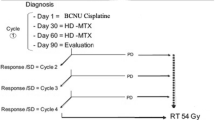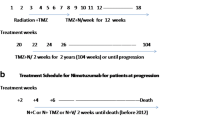Abstract
Background
Diffuse intrinsic pontine glioma (DIPG) is a rare, aggressive brain tumor with no known cure. Reirradiation (reRT) at recurrence can prolong survival. The impact of irradiation may be heightened when combined with PD-1 inhibition. We describe our experience using reRT, with or without PD-1 inhibition, in a cohort of patients with recurrent DIPG.
Methods
We performed a retrospective cohort analysis of children who received reRT with or without concomitant PD-1 inhibition for recurrent DIPG at a single institution between 2005 and 2016. We compared progression-free (PFS) and overall survival (OS) between those who received reRT alone or in combination with PD-1 inhibition. We then compared reRT to a cohort of patients who did not receive reRT.
Results
Thirty-one patients were included (8—reRT with nivolumab; 4—reRT alone; 19—no reRT). Patients who received reRT had prolonged OS compared to no reRT (22.9 months—reRT with nivolumab; 20.4 months—reRT alone; 8.3 months—no reRT; p < 0.0001). Patients who received reRT with nivolumab vs. reRT only had slightly prolonged OS from diagnosis and from reRT (22.9 vs. 20.4 months for time from diagnosis; 6.8 vs. 6.0 months for time from reRT). All patients receiving reRT with or without nivolumab tolerated the therapy without acute or late toxicity.
Conclusions
Our experience demonstrates the tolerability of reRT with concurrent PD-1 inhibition for recurrent DIPG and suggests that combination therapy may offer survival benefit. Future prospective studies are needed to confirm the benefits of this combination therapy.



Similar content being viewed by others
References
Allen J, Siffert J, Donahue B et al (1999) A phase I/II study of carboplatin combined with hyperfractionated radiotherapy for brainstem gliomas. Cancer 86:1064–1069
Chintagumpala M, Gajjar A (2015) Brain tumors. Pediatr Clin North Am 62:167–178. https://doi.org/10.1016/j.pcl.2014.09.011
Cohen KJ, Broniscer A, Glod J (2001) Pediatric glial tumors. Curr Treat Options Oncol 2:529–536. https://doi.org/10.1007/s11864-001-0074-9
Kaye EC, Baker JN, Broniscer A (2014) Management of diffuse intrinsic pontine glioma in children: current and future strategies for improving prognosis. CNS Oncol 3:421–431. https://doi.org/10.2217/cns.14.47
Lam S, Lin Y, Auffinger B, Melkonian S (2015) Analysis of survival in pediatric high-grade brainstem gliomas: A population-based study. J Pediatr Neurosci 10:199–206. https://doi.org/10.4103/1817-1745.165656
Packer RJ (1994) Diagnosis, treatment, and outcome of primary central nervous system tumors of childhood. Curr Opin Oncol 6:240–246
Hargrave D, Bartels U, Bouffet E (2006) Diffuse brainstem glioma in children: critical review of clinical trials. Lancet Oncol 7:241–248. https://doi.org/10.1016/S1470-2045(06)70615-5
Veldhuijzen van Zanten SEM, Jansen MHA, Sanchez Aliaga E et al (2015) A twenty-year review of diagnosing and treating children with diffuse intrinsic pontine glioma in The Netherlands. Expert Rev Anticancer Ther 15:157–164. https://doi.org/10.1586/14737140.2015.974563
Walston S, Hamstra DA, Oh K et al (2015) A multi-institutional experience in pediatric high-grade glioma. Front Oncol 5:28. https://doi.org/10.3389/fonc.2015.00028
Broniscer A, Gajjar A (2004) Supratentorial high-grade astrocytoma and diffuse brainstem glioma: two challenges for the pediatric oncologist. Oncologist 9:197–206
Schild SE, Stafford SL, Brown PD et al (1998) The results of radiotherapy for brainstem tumors. J Neurooncol 40:171–177
Nazarian J, Mason GE, Ho CY et al (2016) Histological and molecular analysis of a progressive diffuse intrinsic pontine glioma and synchronous metastatic lesions: a case report. Oncotarget 7:42837–42842. https://doi.org/10.18632/oncotarget.10034
Sethi R, Allen J, Donahue B et al (2011) Prospective neuraxis MRI surveillance reveals a high risk of leptomeningeal dissemination in diffuse intrinsic pontine glioma. J Neurooncol 102:121–127. https://doi.org/10.1007/s11060-010-0301-y
Donahue B, Allen J, Siffert J et al (1998) Patterns of recurrence in brain stem gliomas: evidence for craniospinal dissemination. Radiation Oncology Biology 40:677–680
Wolff JE, Rytting ME, Vats TS et al (2012) Treatment of recurrent diffuse intrinsic pontine glioma: the MD Anderson Cancer Center experience. J Neurooncol 106:391–397. https://doi.org/10.1007/s11060-011-0677-3
Lassaletta A, Strother D, Laperriere N et al (2018) Reirradiation in patients with diffuse intrinsic pontine gliomas: the Canadian experience. Pediatr Blood Cancer 65:e26988. https://doi.org/10.1002/pbc.26988
Miyazaki T, Ishikawa E, Matsuda M et al (2017) Assessment of PD-1 positive cells on initial and secondary resected tumor specimens of newly diagnosed glioblastoma and its implications on patient outcome. J Neurooncol 133:277–285. https://doi.org/10.1007/s11060-017-2451-7
Garber ST, Hashimoto Y, Weathers S-P et al (2016) Immune checkpoint blockade as a potential therapeutic target: surveying CNS malignancies. Neuro-Oncology 18:1357–1366. https://doi.org/10.1093/neuonc/now132
Berghoff AS, Kiesel B, Widhalm G et al (2015) Programmed death ligand 1 expression and tumor-infiltrating lymphocytes in glioblastoma. Neuro-Oncology 17:1064–1075. https://doi.org/10.1093/neuonc/nou307
Hwang K, Koh EJ, Choi EJ et al (2018) PD-1/PD-L1 and immune-related gene expression pattern in pediatric malignant brain tumors: clinical correlation with survival data in Korean population. J Neurooncol 54:307–311. https://doi.org/10.1007/s11060-018-2886-5
Majzner RG, Simon JS, Grosso JF et al (2017) Assessment of programmed death-ligand 1 expression and tumor-associated immune cells in pediatric cancer tissues. Cancer 123:3807–3815. https://doi.org/10.1002/cncr.30724
Bouffet E, Larouche V, Campbell BB et al (2016) Immune checkpoint inhibition for hypermutant glioblastoma multiforme resulting from germline biallelic mismatch repair deficiency. J Clin Oncol 34:2206–2211. https://doi.org/10.1200/JCO.2016.66.6552
Wainwright DA, Chang AL, Dey M et al (2014) Durable therapeutic efficacy utilizing combinatorial blockade against IDO, CTLA-4, and PD-L1 in mice with brain tumors. Clin Cancer Res 20:5290–5301. https://doi.org/10.1158/1078-0432.CCR-14-0514
Reardon DA, Gokhale PC, Klein SR et al (2016) Glioblastoma eradication following immune checkpoint blockade in an orthotopic, immunocompetent model. Cancer Immunol Res 4:124–135. https://doi.org/10.1158/2326-6066.CIR-15-0151
Sharabi AB, Lim M, DeWeese TL, Drake CG (2015) Radiation and checkpoint blockade immunotherapy: radiosensitisation and potential mechanisms of synergy. Lancet Oncol 16:e498–e509. https://doi.org/10.1016/S1470-2045(15)00007-8
Zeng J, See AP, Phallen J et al (2013) Anti-PD-1 blockade and stereotactic radiation produce long-term survival in mice with intracranial gliomas. Int J Radiat Oncol Biol Phys 86:343–349. https://doi.org/10.1016/j.ijrobp.2012.12.025
Hellmann MD, Friedman CF, Wolchok JD (2016) Combinatorial cancer immunotherapies. Adv Immunol 130:251–277. https://doi.org/10.1016/bs.ai.2015.12.005
Kiess AP, Wolchok JD, Barker CA et al (2015) Stereotactic radiosurgery for melanoma brain metastases in patients receiving ipilimumab: safety profile and efficacy of combined treatment. Int J Radiat Oncol Biol Phys 92:368–375. https://doi.org/10.1016/j.ijrobp.2015.01.004
Knisely JPS, Yu JB, Flanigan J et al (2012) Radiosurgery for melanoma brain metastases in the ipilimumab era and the possibility of longer survival. J Neurosurg 117:227–233. https://doi.org/10.3171/2012.5.JNS111929
Fried I, Lossos A, Ben Ami T et al (2018) Preliminary results of immune modulating antibody MDV9300 (pidilizumab) treatment in children with diffuse intrinsic pontine glioma. J Neurooncol 136:189–195. https://doi.org/10.1007/s11060-017-2643-1
Hwang EOA, Young-Poussaint T, Mitchell D et al (2018) Outcome of patients with recurrent diffuse intrinsic pontine glioma (DIPG) treated with pembrolizumab (anti-PD-1): a Pediatric Brain Tumor Consortium sutdy (PBTC045). In: International Society of Pediatric Neuro-Oncology; July 1–July 3, Denver, CO Abstract presented as IMMU-09
Wolchok JD, Kluger H, Callahan MK et al (2013) Nivolumab plus ipilimumab in advanced melanoma. N Engl J Med 369:122–133. https://doi.org/10.1056/NEJMoa1302369
Vlahovic G, Fecci PE, Reardon D, Sampson JH (2015) Programmed death ligand 1 (PD-L1) as an immunotherapy target in patients with glioblastoma. Neuro-Oncol 17:1043–1045. https://doi.org/10.1093/neuonc/nov071
Trainer H, Hulse P, Higham CE et al (2016) Hyponatraemia secondary to nivolumab-induced primary adrenal failure. Endocrinol Diabetes Metab Case Rep. https://doi.org/10.1530/EDM-16-0108
Vandiver JW, Singer Z, Harshberger C (2016) Severe hyponatremia and immune nephritis following an initial infusion of nivolumab. Target Oncol 11:553–556. https://doi.org/10.1007/s11523-016-0426-9
Janssens GO, Gandola L, Bolle S et al (2017) Survival benefit for patients with diffuse intrinsic pontine glioma (DIPG) undergoing re-irradiation at first progression: a matched-cohort analysis on behalf of the SIOP-E-HGG/DIPG working group. Eur J Cancer 73:38–47. https://doi.org/10.1016/j.ejca.2016.12.007
Freese C, Takiar V, Fouladi M et al (2017) Radiation and subsequent reirradiation outcomes in the treatment of diffuse intrinsic pontine glioma and a systematic review of the reirradiation literature. Pract Radiat Oncol 7:86–92. https://doi.org/10.1016/j.prro.2016.11.005
Massimino M, Biassoni V, Miceli R et al (2014) Results of nimotuzumab and vinorelbine, radiation and re-irradiation for diffuse pontine glioma in childhood. J Neurooncol 118:305–312. https://doi.org/10.1007/s11060-014-1428-z
Fontanilla HP, Pinnix CC, Ketonen LM et al (2012) Palliative reirradiation for progressive diffuse intrinsic pontine glioma. Am J Clin Oncol 35:51–57. https://doi.org/10.1097/COC.0b013e318201a2b7
Castel D, Philippe C, Calmon R et al (2015) Histone H3F3A and HIST1H3B K27M mutations define two subgroups of diffuse intrinsic pontine gliomas with different prognosis and phenotypes. Acta Neuropathol 130:815–827. https://doi.org/10.1007/s00401-015-1478-0
Khuong-Quang D-A, Buczkowicz P, Rakopoulos P et al (2012) K27M mutation in histone H3.3 defines clinically and biologically distinct subgroups of pediatric diffuse intrinsic pontine gliomas. Acta Neuropathol 124:439–447. https://doi.org/10.1007/s00401-012-0998-0
Mandell LR, Kadota R, Freeman C et al (1999) There is no role for hyperfractionated radiotherapy in the management of children with newly diagnosed diffuse intrinsic brainstem tumors: results of a Pediatric Oncology Group phase III trial comparing conventional vs. hyperfractionated radiotherapy. Radiat Oncol Biol 43:959–964
Freeman CR, Krischer JP, Sanford RA et al (1993) Final results of a study of escalating doses of hyperfractionated radiotherapy in brain stem tumors in children: a Pediatric Oncology Group study. Radiat Oncol Biol 27:197–206
Svolos P, Reddick WE, Edwards A et al (2017) Measurable supratentorial white matter volume changes in patients with diffuse intrinsic pontine glioma treated with an anti-vascular endothelial growth factor agent, steroids, and radiation. AJNR Am J Neuroradiol 38:1235–1241. https://doi.org/10.3174/ajnr.A5159
van den Bent MJ, Vogelbaum MA, Wen PY et al (2009) End point assessment in gliomas: novel treatments limit usefulness of classical Macdonald’s Criteria. J Clin Oncol 27:2905–2908. https://doi.org/10.1200/JCO.2009.22.4998
Wong ET, Lok E, Gautam S, Swanson KD (2015) Dexamethasone exerts profound immunologic interference on treatment efficacy for recurrent glioblastoma. Br J Cancer 113:232–241. https://doi.org/10.1038/bjc.2015.238
Okada H, Weller M, Huang R et al (2015) Immunotherapy response assessment in neuro-oncology: a report of the RANO working group. Lancet Oncol 16:e534–e542. https://doi.org/10.1016/S1470-2045(15)00088-1
Funding
C.N.K. is supported by Frank A. Campini Foundation, Cannonball Kids’ Cancer [A129749], and National Institutes of Health National Center for Advancing Translational Sciences [KL2TR001870-This content is solely the responsibility of the authors and does not necessarily represent the official views of the NIH]. The research was supported in part by the William M. Wood Foundation (D.H.K).
Author information
Authors and Affiliations
Corresponding authors
Ethics declarations
Conflict of interest
The authors of this manuscript have no conflicts of interest and no financial or other interest to disclose.
Rights and permissions
About this article
Cite this article
Kline, C., Liu, S.J., Duriseti, S. et al. Reirradiation and PD-1 inhibition with nivolumab for the treatment of recurrent diffuse intrinsic pontine glioma: a single-institution experience. J Neurooncol 140, 629–638 (2018). https://doi.org/10.1007/s11060-018-2991-5
Received:
Accepted:
Published:
Issue Date:
DOI: https://doi.org/10.1007/s11060-018-2991-5




